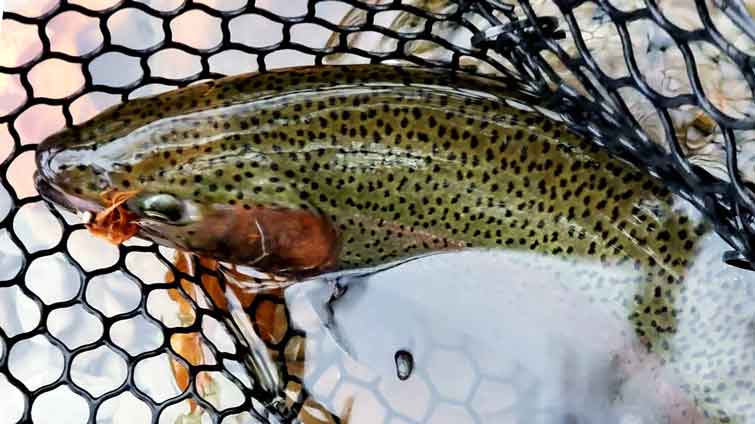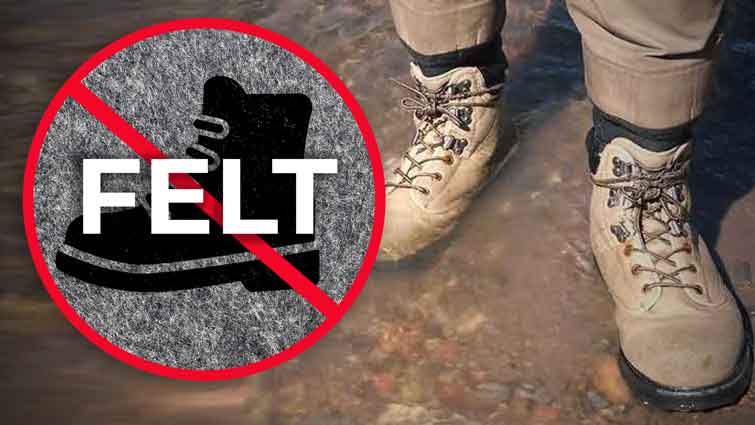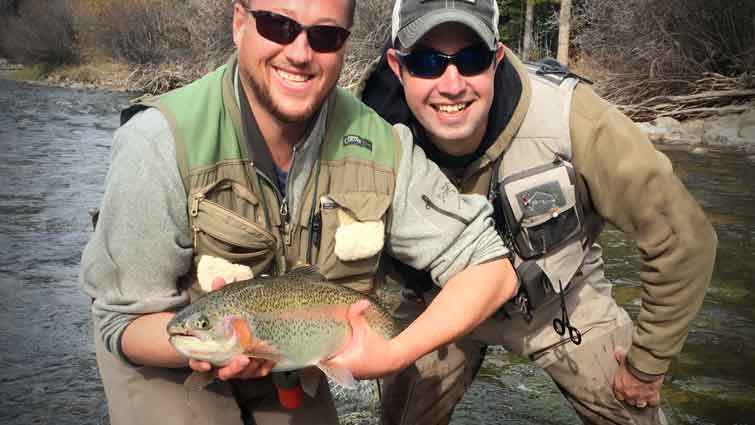The accessories you need for fly fishing will vary depending on your individual preferences and needs. However, there are some basic fly fishing gear that every fly fisherman should have in his or her arsenal.

As a general rule some of the most essential fly fishing accessories include:
- Floatant
- Tippet
- A good pair of waders
- Leader
- A net
- Fly fishing vest
- Zingers
- Forceps
- Boots
- Poloraized Sun Glasses
- Removable Split Shot
You may also want to consider investing in some additional items such as a net, and a pair of polarized sunglasses. In this article, we will discuss each of these essential fly fishing accessories in more detail.

1. Floatant
If you are a fly fisherman that prefers fishing dry flies, you will want to use a floatant on your flies to help them stay afloat. There are many different types of floatants available on the market, and you may have to experiment a bit to find the one that works best for you. Some popular brands include:
- Gink
- Fly Agra
- Loon Aquel Gel Floatant
- Tiemco Dry Magic
Floatant creates a water-repelling gel coating around the fly. The basic materials include a coating of water-repelling gel and an oily lubricant, which is applied directly to the fly. It should only be used when the fly is dry before any water comes into contact with the fly.

2. Tippet
Tippet is a very important piece of gear for any fly fisherman. Tippet is the line that connects your fly to your leader, and it is important to use a tippet that is strong enough to handle the fish you are targeting.
Tippet is a measurement of fluorocarbon or monofilament line connected to the end of the leader, from which you secure the fly. The tippet is generally the smallest gauge line on your rig and goes unnoticed by fish. Tippet also has a lot of give, allowing your fly to float or swim more naturally.
Choosing the right tippet material is essential. Most fly fishermen use tippet made from either:
- Monofilament - Monofilament tippet is the most popular and affordable choice, but it can be more visible to fish and is not as durable as fluorocarbon.
- Fluorocarbon - Fluorocarbon tippet is more expensive, but it is nearly invisible in the water and has a high degree of knot strength.
The tippet needs to be thick enough to resist the fighting strength of a fish without breaking, yet it also has to be thin enough for you to cast a light fly accurately. Tippets that are heavier are harder to throw, while tippets that are too delicate might not be able to land fish.

3. Waders
Waders are an essential piece of gear for any fly fisherman fishing in streams or rivers. Waders keep you dry and comfortable even when you're waist-deep in the water. There are a number of waders on the market, so it's vital to get the right pair for your needs.
The best waders for fishing are lightweight, comfortable, and keep you dry. For safety, they should be the proper size and belted, as well as footed and give good traction in water with algae or moss.
Waders may appear to be a waste of money when many anglers fish without them, but the advantages of waders greatly outweigh their cost.

Chest Waders
Chest waders are the most common type of wader. They extend up to the waist, and they have a belt that helps keep them in place. Chest waders are ideal for fly fishermen who want to get wet and explore the underwater world. Chest waders are also great for fishing in cold weather, as they help keep you warm.
Chest waders feature neoprene socks attached to the legs, which keep your feet warm and protect them from rocks and other sharp objects. They also have a lining in the chest area, which keeps you warm and helps prevent water from entering the wader.
Hip Waders
Hip waders are similar to chest waders, but they extend only to the hip area. Hip waders are ideal for fishing in shallow water or on calm days when you don’t need to be waist-deep in the water. They also work well in cold weather, as they help keep you warm.
Hip waders, like chest waders, come with attached neoprene socks, which keep your feet warm and protect them from rocks and other sharp objects.
Boot Waders
Boot waders are perfect for anglers who spend a lot of time walking through deep water. They have boot attachments that keep your feet warm and dry, and they come in a variety of sizes to fit any angler. These types of waders also come in chest or hip lengths. The main difference is that they don't require a boot to be worn on top, so they're a little more lightweight and easier to move around in.

4. Leaders
Leaders are also an important part of any fly fisherman's gear arsenal. Leaders are used to connect the tippet to the fly line, and they come in a variety of lengths and strengths. It is important to choose a leader that is matched to the type of fishing you will be doing.
Leaders come in multiple sizes and strengths to help fly fishermen connect the tippet to the fly line. Your leader is an important part of your fishing gear and should be matched to the type of fishing you will be doing.

5. Fly Fishing Net
Nets are a useful tool for landing fish while fly fishing, but they aren't absolutely necessary. If you're fly fishing in a small stream or pond, you may be able to simply seize the fish and pull it out of the water. A net will come in handy if you're fishing in a larger body of water because it allows you to land bigger fish. Rubber mesh nets are ideal for trout and other smaller species.
Nets can attach to your gear with a holster or a belt clip. You should also look for a net bag for storage.

6. Fly Fishing Vest
A fly fishing vest is a great accessory to have because it allows you to carry all of your essential gear with you while you're fishing. Vests come in a variety of sizes and styles, so you can find one that's perfect for your needs. Most vests have multiple pockets and compartments, which allow you to store flies, tippets, leaders, nets, and other gear. Some vests also come with built-in waterproof storage for holding maps and important documents.
A fly fishing vest is a great piece of clothing to have on hand when fly fishing. It provides you with storage for your tackle and other gear, and it can help keep you warm on those cool days. A good vest will have many pockets as well as a comfortable fit.

When looking for a fly fishing vest, there are a few important features to look for. The first thing you'll want to think about is the weather where you fish. If you fish in cold weather, you'll need a vest with thermal insulating capabilities.
A vest with ventilation will keep you cool if you fish in hot weather. Another consideration is the quantity of gear you intend on carrying. Some vests have numerous pockets and compartments, while others are more streamlined. You'll need a vest with lots of storage capacity if you want to carry a lot of stuff.
6. Zingers
Zingers are a useful accessory for fishermen. They're essentially retractable lanyards that eliminate the need to look for important tools like nippers while on the water. This might save you time, energy, and aggravation on the river. A zinger is a retractable lanyard that clips to the fly fisherman's vest or bag and allows you to access your fly fishing gear. Accessories such as hemostats, nippers, and other items are frequently connected to a zinger's detachable cord.

7. Forceps
Forceps are a necessary tool for every fly fisherman. They are used to remove hooks from fish's mouths, and they can also be used to pinch the barb on a hook so that it is easier to remove.
Forceps are primarily used to remove flies from the fish safely and conveniently, and they can also be used to pick up flies from their storage and hold them firmly while the angler is attaching them to the tippet or leader. In essence, it is a safety tool for the angler to prevent injury from flies.
Some forceps models also come with built-in scissors, which can be very handy when trimming tippet material. The scissors usually have a small notch in them so that they can easily cut through monofilament or fluorocarbon materials without damaging the line.

8. Nippers
Nippers are another essential tool for every fly fisherman. They are used to trim the tag end of the tippet after tying on a fly, and they can also be used to cut away excess leader material. Nippers come in a variety of shapes and sizes, but the most important thing is that they are sharp so that they can easily cut through the tippet material.
They can be used to trim the excess line from your fly line, which can help you cast more accurately. There are a variety of different nippers on the market, but most of them work in a similar fashion. They have a small blade that is used to cut the line, and they also typically have a notch or hole in them so that you can easily hold onto the line while you’re clipping it.

9. Boots
If you don’t want to purchase waders, or if the water level is too low to justify wearing them, you can always buy wading shoes. Wading shoes are exactly what they sound like - waterproof shoes designed specifically for fly fishing. They have a thick rubber sole that provides good traction in wet environments, and they come in both men's and women's sizes. Some anglers also choose to wear wading shoes when fishing from a boat, as they provide extra protection against wet feet.
When it comes to choosing a pair of boots for fly fishing, there are a few things to consider. First, you'll need to determine the type of environment you'll be fishing in. If you're fishing in streams and rivers, lightweight boots that can easily traverse through water are required. If you're fly fishing in chilly climates, insulated boots that keep your feet warm even when the temperature drops below freezing might be beneficial.
When you’re looking for a new pair of fly fishing boots, it’s important to do your research and find the right pair for your needs. There are several different factors to consider, including:
- Style of boots
- Sole Material
- Insulation
- Cleats
- Boot Materials
Wader boots are used by fly fishermen to provide an extra layer of insulation and protection against cold water. However, if you are fishing in a climate where the water temperature is above 50 degrees, you will likely be fine wearing regular boots.

10. Polarized Sunglasses
Polarized lenses are ideal for spotting fish underwater. The polarization blocks the glare from above and helps you to see into the depths of the water. Furthermore, polarized glasses allow for optimal vision in all types of weather, including clear or hazy water as well as water that is deeper than 10 feet.
When choosing polarized sunglasses to invest in, consider the conditions you typically fish in. For example, if you are fishing in hazy, overcast conditions, then a lighter lens color would be best. If it happens to be sunny, choose darker lenses to reduce the intensity of the sun's glare.
Consider investing in mirrored lenses if you are fishing on flat water or in clear conditions. These lenses are great for low light conditions, and they will help reflect the sun away from your eyes. The mirrored coating also helps prevent haze and atmospheric disturbances that may affect your vision.

11. Removable Split Shot
There are three main fly-fishing techniques; dry fly fishing, nymph fly fishing, and Streamer fishing. Nymphing uses sub-surface artificial flies called nymphs in different life stages to catch underwater trout.
When you decide to go for the nymph fly fishing approach, you should use it for fish in a particular section of the water called the “strike zone.” Utilizing a split shot above your flies will help bring them down into the strike zone faster for a greater chance at more fish.
Fly fishing accessories are a necessary part of your gear, and they can help make your fishing experience more enjoyable. By choosing the right accessories for your needs, you can increase your chances of success on the water.
So, what fly fishing accessories do you need? It depends on the conditions you typically fish in, but some essential items include polarized sunglasses, tippet, leaders, a good pair of waders, and more. Remember to invest in quality gear that will last, and you'll be ready to hit the water with confidence!





